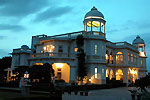|
|
| |
|
Gujarat Tours |
|
|
|
|
| |
|
|
| |
|
|
| |
|
|
| |
|
Gujarat Hotels |
|
|
 |
|
|
|
|
Patan Attractions |
|
|
|
|
|
The major tourist
attractions in Patan are Rani ki Vav, Sahastralinga Talav
and Khan Sarovar. |
|
|
|
Rani ki
Vav
The Rani ki Vav, a step well in Patan is an excellent
example of subterranean architecture in Gujarat and
has steps that lead down to the water level. This Vav
is situated about 134 km north-west of Ahmedabad, and
about 57 km from Mehsana. The Rani ki Vav was built by
Rani Udayamti of the Solanki dynasty, probably as a
memorial for her husband Bhimdeva I (1022 - 1063 AD).
This Vav represents the finest of the Indian
sculptures and architecture and forms the link between
a kunda and the classical step-well. In addition to
the straight staircase, it also has lateral
staircases, along with very broad, stepped corridors.
The entrance of this Vav is situated in the east and
|
 |
|
|
the well in the west. The
exquisitely carved side walls, pillars, steps and platforms
lead to the elaborately carved water well. Although, this
Vav is in a bad condition, but still the entrance, the side
walls of the stepped corridor, some of the mandapas and the
back wall of the well are still in a perfect condition. Five
lateral, staggered staircases attached to the side walls
connect various storeys. Every surface of the well and
levels are adorned with fine sculptures of Hindu deities,
religious motifs and geometrical patterns. The lower most
level has 37 niches with rudimentary images of Ganesha in
the centre and images of the Sheshashayi Vishnu on the upper
level. On the upper levels, the impressive images of
Laxmi-Narayana, Uma-Mahesh, Brahma-Brahmani, Kubera and
Ganesha, with their respective consorts are also sculpted.
On the lower levels, there are images of Vishnu’s
incarnations and 24 forms but the Kufma and the Matsya
avatars do not find a place in this Vav. No other Vav in
India is so profusely adorned as the Rani ki Vav. |
|
|
|
Sahastralinga Talav
Sahastralinga Talav, an artificial tank, was built by
the Siddhraj Jaisingh (1093 -1143 AD), the Chalukyan
ruler of Gujarat in Patan. This tank is situated on
the north-western part of Patan, on the banks of the
Saraswati river. The architecture of this tank
integrated the great sense of water management and
sanctity of water in Hindu religion. The tank used to
receive water from a canal of the Saraswati river and
had spread about five km with masonry embankments.
About thousand of shrines dedicated to the Lord Shiva
were constructed on the edge of the water tank, but
now there are remains of only some shrines. Looking at
the ruins, one can imagine the grandeur of this great
water tank. An inscription found in the Shiva temple
in Vyala Kua |
 |
|
|
Street of Patan indicates
that the lake was part of a much larger work. At present,
the Sahastralinga Talav is dry and the earth work are buried
under the sands of the Saraswati river, the same river that
was once filled with water. According to some local people
the tank was dry to the curse given by the Jasma Oden. A
famous story of Siddhraj Jaisingh and Jasma Odan, a
beautiful woman of the tank diggers’ community, revolves
around this tank. She refused to marry the Siddhraj and
committed Sati to protect her honour. It is believed that
her curse made this tank waterless and the king without a
heir to the kingdom of Gujarat. The Sahastralinga Talav is
pentagonal in shape, and marked by a series of mounds
showing its shape. The earthworks circumscribe an area of
several kilometers and about 1 km broad. The total area of
the Talav is about 17 hectares. At its fullest, it would
have contained about 4,206,500 cubic metres of water. In the
centre of the Talav is a large earth heap, the Bakasthana.
On a raised platform over it, was built a rauza, an
octagonal structure of Lakhori bricks. The most interesting
of the relics are the channels, the well, steps and side
elevation of the Talav, and a bridge. The channel runs from
north to south and connected the lake to the Saraswati
river.
Khan Sarovar
Khan Sarovar is located outside South Gate. This is a water
tank from Solanki period with stone steps and masonry. Mirza
Aziz Kokah renovated this tank using the stones from ruined
structures.
Hemachandracharya Gyan Mandir
Hemachandracharya Gyan Mandir contains thousands of rare
ancient manuscripts in Sanskrit and Prakrit.
Hemachandracharya was a great scholar and grammarian, the
first one to formulate the grammar of the Gujarati language.
Temples
There are 100 Jain temples in Patan. The most important Jain
temple is the Mahavir Swami Derasar in Dhandherwad with
exquisitely carved wooden dome. The important Hindu temples
are Kalika Mata, Sindhwai Mata, Harihareshwar Mahadev and
Brahma Kund. |
|